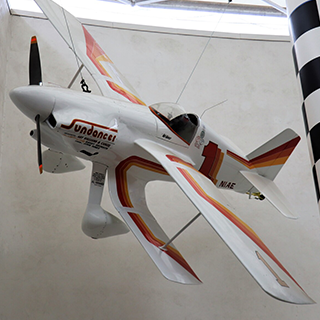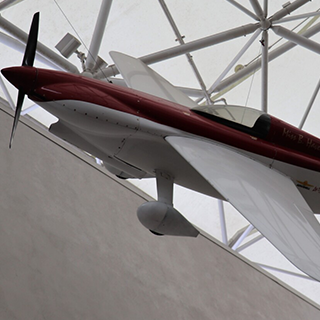
Sundancer is an all metal sport racing biplane which took the biplane racing world by storm in the early 1970s. Unlike many other racers in its class, there is no wood and very little fiber-glass used in Sundancer’s construction. Dr. Sydney White began the build project in 1969 with the goal of finishing in 2-3 years. To accelerate the project, Dr. White purchased the design drawings, and any parts that he could of the fuselage, canopy, empennage, and propeller spinner of the “Midget Mustang” racer sold in kit form by Robert Busby.

As part of our exhibit in the Museum’s Pavilion of Flight titled, Speed: Science in Motion, the Reno Nevada Formula air race aircraft Miss B Haven Model DG-1 flies along with two other racers representing a category of racer capable of speeds exceeding 240 miles per hour. In the display, these aircraft are positioned as they would be racing around the pylons at the Reno Air Races.

The first airplane to cross the English Channel was the Bleriot XI. This historic event took place on July 25, 1909, and overnight the Bleriot XI became one of the most important airplanes of its era. Between July 1909 and August 1914, over 800 Bleriot XIs were produced. T

Affectionately called “Jenny” by thousands of fledgling World War I combat pilots, the Curtiss JN-4D was the most widely used primary trainer in the United States as America prepared to go to war in the air over Europe. Built between 1915 and 1917 by the Curtiss Aeroplane Company of Hammondsport, New York, it was the trainer for an entire generation of aviators in the United States, Canada, and Great Britain.
2001 Pan American Plaza, San Diego, CA
Phone: 619.234.8291
Información En Español
Contact Us
We would like to thank all our sponsors who help us make a difference. Click here to view all who help us.

The San Diego Air & Space Museum is a 501(c)(3) non-profit organization. Federal Tax ID Number 95-2253027.
